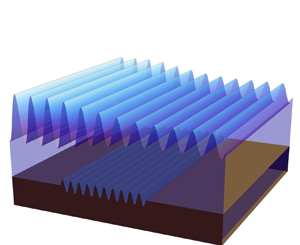Published online by Cambridge University Press: 11 January 2024

Based on the multiple-scale expansion technique, a new set of extended nonlinear Schrödinger (ENLS) equations up to the third order is derived to account for the additional high-order bottom and dispersion effects as well as the nonlinear wave interaction on wave transformation over periodic sandbars of sinusoidal geometry. By employing the small-amplitude wave assumption, a closed-form analytical solution for Bragg scattering is obtained from the linearised ENLS equations, which demonstrates that a downshift of wave frequency of the maximum reflection is mainly due to the inclusion of the high-order bottom effect. The factors that affect the downshift of the resonant frequency are identified and a theoretical expression in parabolic form is derived to quantify the downshift magnitude. The fully ENLS equations are further analysed to reveal the additional wave nonlinear effects on Bragg scattering characteristics. Under the condition of infinitesimal sandbar amplitude, the ENLS equations render a theoretical expression of the critical value of  $kh$ when the nonlinear wave self-modulation effect and the nonlinear wave cross-modulation effect are equal, whereas the former effect is responsible for wavenumber upshifting and the latter downshifting. When
$kh$ when the nonlinear wave self-modulation effect and the nonlinear wave cross-modulation effect are equal, whereas the former effect is responsible for wavenumber upshifting and the latter downshifting. When  $kh$ is larger than the critical value, the increase of wave nonlinearity will enhance the downshift magnitude of the Bragg resonance, and vice versa. For finite amplitude of the bottom sandbar, the ENLS equations are solved numerically to examine the influence of both wave nonlinearity and sandbar amplitude on the characteristics of Bragg resonance. The results reveal that as the increase of sandbar amplitude, the critical
$kh$ is larger than the critical value, the increase of wave nonlinearity will enhance the downshift magnitude of the Bragg resonance, and vice versa. For finite amplitude of the bottom sandbar, the ENLS equations are solved numerically to examine the influence of both wave nonlinearity and sandbar amplitude on the characteristics of Bragg resonance. The results reveal that as the increase of sandbar amplitude, the critical  $kh$ increases monotonically.
$kh$ increases monotonically.